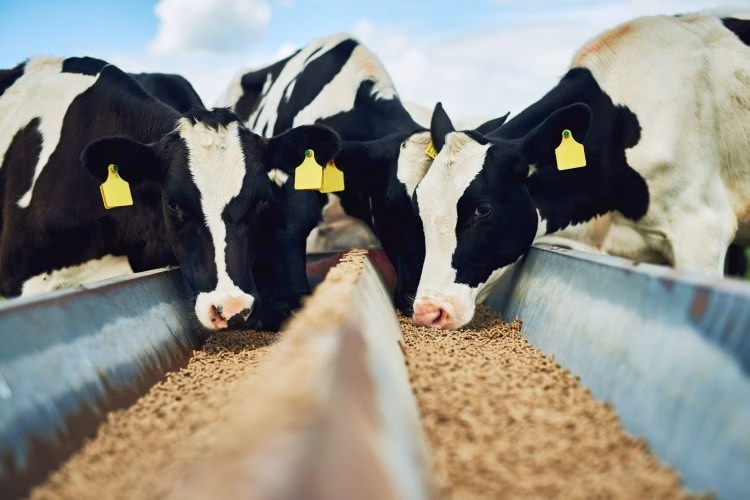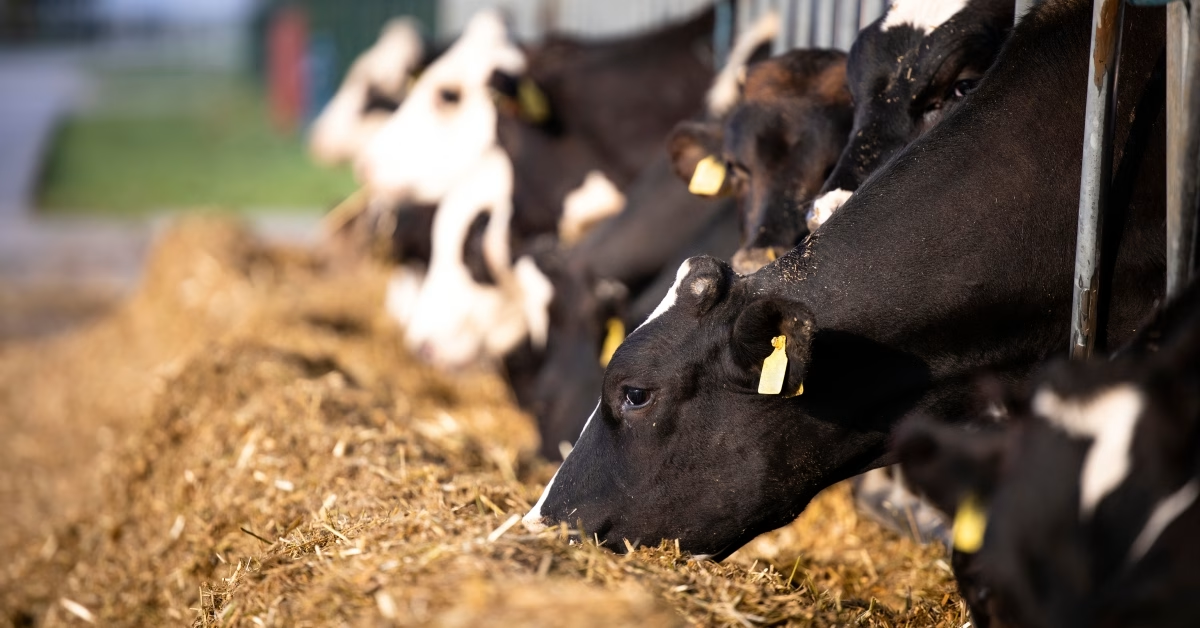Learn about the benefits of 25-Hydroxy D3 supplements for dairy cows. How can this improved form of vitamin D boost cow health, strengthen immunity, and improve overall performance?

Do you think vitamin D is just about sun exposure and bone health? Think again. New research suggests that 25-hydroxy D3 supplementation may significantly improve the health of dairy cows. This finding, similar to the discovery of vitamin D in the 1920s, has the potential to improve dairy cow health and output dramatically. It is critical for keeping calcium levels stable in all animals, especially dairy cows. Cows with low calcium levels may have milk fever, which may cause muscular difficulties.
But vitamin D’s effects extend beyond the bones. It helps prevent cancer and, more significantly, strengthens the immune system. Enter 25-hydroxy D3, a more straightforward vitamin D for cows to absorb, improving overall health. This new supplement enhances calcium recovery and serves as a shield, reinforcing dairy cows’ immune systems. This improvement in dairy farming promises a healthier herd.
So why should you care? Healthy cows provide better milk, resulting in safer and higher-quality dairy products. Embracing the advantages of 25-hydroxy D3 may help the dairy business and encourage sustainability.
Unveiling the Power of Vitamin D: A Century of Calcium Mastery and Dairy Health. The potential of 25-hydroxy D3 supplements to transform dairy herd management is a testament to the continuous evolution of dairy farming practices.
The potential of 25-hydroxy D3 supplements to improve dairy herd management demonstrates the ongoing development of dairy farming operations. Vitamin D was discovered in the early 1920s while researchers studied rickets, a calcium shortage condition. They noticed that sunshine exposure may prevent rickets, which led to the discovery of vitamin D’s critical function in calcium homeostasis. Maintaining adequate calcium levels is crucial for dairy cows’ health and output. Vitamin D promotes calcium absorption from the stomach. Nonetheless, without enough of it, cows risk experiencing milk fever, which inhibits muscular function owing to low blood calcium levels.
The Critical Role of Vitamin D in Dairy Cow Calcium Homeostasis
Vitamin D is essential for maintaining calcium levels and performing normal physiological processes. It helps dairy cows absorb calcium from their food. Cows cannot absorb calcium properly if they do not have enough vitamin D, which causes shortages.
A significant issue is milk fever, caused by low blood calcium levels at calving time. This occurs when the cow requires more calcium for milk production but cannot move enough, resulting in muscular weakness and limited mobility. In extreme circumstances, it may be lethal.
Vitamin D prevents milk fever by controlling calcium levels, increasing calcium absorption from the stomach, and mobilizing calcium from bones. However, although vital, vitamin D alone is insufficient to prevent milk fever. Maintaining stable calcium levels requires a complete strategy, including dietary modifications and mineral supplementation.
The Limitations of Vitamin D3 Conversion in Dairy Cows: What You Need to Know
Though this mechanism is limited, dairy cows may convert vitamin D3 from sunshine or supplementation to 25-hydroxy D3. This conversion occurs in the liver, where enzymes convert vitamin D3 to 25-hydroxy D3, the precursor of active vitamin D. This form circulates in the circulation and promotes calcium metabolism. However, the liver can only synthesize a certain amount of 25-hydroxy D3 at a time. Once this limit is reached, excess vitamin D3 is not metabolized correctly, resulting in lower-than-optimal amounts of 25-hydroxy D3 in the blood. This constraint is critical during the prenatal and postnatal periods when dairy cows need appropriate calcium management. This knowledge of the conversion process emphasizes the need for 25-hydroxy D3 supplementation in preserving cow health.
The Journey to 25-Hydroxy D3 Supplements in Dairy Cows: Bridging Nutritional Gaps
Introducing 25-hydroxy D3 supplements significantly advances animal nutrition, particularly for ruminants. These supplements have been utilized in poultry for over 30 years, although their usage in dairy cows is relatively recent. Europe has just recently legalized their usage. However, several nations have been using them for the previous five to ten years. So, why is there a wait for dairy cows?
Two major elements led to this. First, there needs to be more urgency. Poultry have a harder time absorbing vitamin D3; thus, 25-hydroxy D3 tablets are especially effective. Second, it was considered that ruminants could metabolize enough vitamin D3 to 25-hydroxy D3, making supplementation unnecessary.
However, a new study has indicated that ruminants cannot convert vitamin D3. This finding has increased interest in 25-hydroxy D3 supplementation for dairy cows, which may enhance calcium metabolism and general health. These supplements are helpful when cows’ vitamin D3 conversion is insufficient, such as in the prepartum period.
This comparison of poultry and dairy cows demonstrates their different dietary requirements and reactions. These supplements have been approved, allowing dairy producers to have healthier herds.
Vitamin D3 vs. 25-Hydroxy D3: The Biochemical Edge for Animal Health
Understanding the difference between vitamin D3 and 25-hydroxy D3 is essential for animal health. Vitamin D3, or cholecalciferol, is created in the skin when exposed to sunshine, but it must be converted before it becomes physiologically active. This process begins in the liver, where vitamin D3 is converted into 25-hydroxy D3 (calcidiol) by attaching a hydroxyl group (-OH) to the 25th carbon of the vitamin D3 molecule. This change considerably increases the action of the vitamin, making it more beneficial to the cow’s health.
The procedure includes attaching a hydroxyl group (-OH) to the 25th carbon of the vitamin D3 molecule, dramatically increasing its activity. Supplementing dairy cows directly with 25-hydroxy D3 avoids the liver stage, making the vitamin instantly accessible.
This direct supplementation assists animals that cannot convert enough vitamin D3 to 25-hydroxy D3, resulting in efficient and quick absorption in the circulation and improved health results.
Maximizing Efficiency: Why 25-Hydroxy D3 Outshines Vitamin D3 in Dairy Nutrition
Regarding efficiency, 25-hydroxy D3 is better absorbed by the body than vitamin D3. Its enhanced form avoids the liver’s conversion step, making it easily accessible for metabolic functions in dairy cows.
Studies have shown that lesser dosages of 25-hydroxy D3 reach blood levels comparable to greater doses of vitamin D3. Experiments with Holstein dairy calves revealed that half the dose of 25-hydroxy D3 produced identical blood concentrations as vitamin D3. This implies improved absorption and cost-effectiveness.
Dairy cows fed with 25-hydroxy D3 may maintain good health at lower doses. In the United States, rules allow up to three milligrams during the prepartum period, but Europe allows just one milligram. Higher blood 25-hydroxy D levels improve various physiological activities, including the immune system, demonstrating the greater effectiveness of 25-hydroxy D3 supplementation.
Beyond Calcium: Unleashing the Immune-Boosting Power of 25-Hydroxy D3 in Dairy Cows
While the link between vitamin D and calcium is widely understood, the advantages of 25-hydroxy D3 extend considerably further. This metabolite is essential in the immune system because it aids in producing antimicrobial peptides and regulating inflammation, both of which are necessary for general health. Furthermore, 25-hydroxy D3 promotes quicker calcium repair in dairy cows. While it does not prevent milk fever, it may speed up the recovery of calcium levels in cows experiencing hypocalcemia, which is crucial for muscular function and general vitality. 25-hydroxy D3’s anti-inflammatory effects help dairy cows recuperate from stress and increase milk production. This makes 25-hydroxy D3 an essential supplement to dairy nutrition since it promotes bone health, a robust immune system, and quick recovery.
Pioneering Research on Maternal and Fetal Vitamin D: Unlocking Lifelong Health for Dairy Herds
Researchers are studying how maternal and fetal vitamin D metabolism, namely vitamin D3 and 25-hydroxy D3, impact fetal growth and development. They are investigating the effects on skeletal and immune system development. Studies look at how these supplements affect the fetus’s development and immunological resilience, paving the way for better health outcomes throughout the animal’s lifetime. Scientists want to understand better how these approaches improve dairy cows’ overall performance and production by monitoring their impacts throughout gestation and early life. This study suggests that early nutritional adjustments may improve the health and efficiency of dairy cows over time.
The Bottom Line
The finding of 25-hydroxy D3 supplements represents a significant advancement in dairy cow health management. These supplements are a more effective and robust alternative to typical vitamin D3, addressing conversion difficulties in dairy cows.
We’ve seen how vitamin D affects calcium control and the distinct advantages of 25-hydroxy D3. These supplements improve calcium recovery after childbirth, strengthen the immune system, and minimize inflammation. 25-hydroxy D3 may improve health outcomes at lower doses than vitamin D3.
The significance of integrating 25-hydroxy D3 into dairy nutrition is evident. Research on maternal and fetal health highlights potential advantages for dairy herd management throughout the lifetime. Embracing 25-hydroxy D3 improves dairy nutrition and promotes healthier, more productive cows.
Investing in this study and using these findings may result in larger, healthier dairy herds. Now is the moment to connect our operations with the most recent scientific advances to ensure the health of our herds.
Key Takeaways:
- Supplementing dairy cows with 25-hydroxy D3 is beneficial for their overall health and calcium regulation.
- Vitamin D, essential for calcium homeostasis, has been known and studied for nearly 100 years.
- While ruminants can convert Vitamin D3 to 25-hydroxy D3, there is a limit to this conversion process.
- 25-hydroxy D3 supplements are more effective and require lower dosages compared to Vitamin D3 for the same health benefits.
- Recent approvals have enabled the use of 25-hydroxy D3 in dairy cows, following its long-standing use in poultry.
- Beyond calcium regulation, 25-hydroxy D3 also enhances immune function by controlling inflammation.
- Ongoing research is focused on the impact of Vitamin D on maternal and fetal health, as well as lifelong bovine performance.
Summary:
Vitamin D, discovered in the 1920s, is crucial for dairy cows’ health and productivity. 25-hydroxy D3 supplements can improve dairy cow health and output by enhancing calcium recovery and strengthening the cows’ immune systems. Healthy cows produce better milk, resulting in safer and higher-quality dairy products. Vitamin D alone is insufficient to prevent milk fever. 25-hydroxy D3 supplements are especially effective for ruminants, as they have a harder time absorbing vitamin D3 and cannot metabolize enough vitamin D3. Direct supplementation avoids the liver stage, making 25-hydroxy D3 instantly accessible. Studies show that 25-hydroxy D3 promotes quicker calcium repair, bone health, a robust immune system, and quick recovery. Integrating 25-hydroxy D3 into dairy nutrition is crucial for promoting healthier, more productive cows.












